- Table of Contents
- Intro
- When It Matters
- How It Works
- Our Tests
- Additional Information
- Comments
- 15.0% PRTF Accuracy (RMS Deviation)
- 15.0% PRTF Size (Avg.)
- 35.0% PRTF Distance
Our PRTF test replaces the Passive Soundstage test that appeared in all headphone reviews prior to Test Bench 2.0. While PRTF isn't entirely new, it was re-formulated as we felt it didn't represent a complete assessment of what constitutes soundstage.
Soundstage determines the space and environment of sound, as created by the headphones. That is, it determines the perceived location and size of the sound field itself, whereas tests like Stereo Mismatch and Group Delay have more of an effect on the location and size of the objects within the sound field. In other words, soundstage is the localization and spatial cues not inherent to the audio content (music), and headphones have to 'create' them rather than 'reproduce' them.
Our pinna-related transfer function (PRTF) test measures the amount of interaction between the pinna and headphones. While it's not a comprehensive and complete measurement of soundstage, interaction with the pinna plays a significant role in the perceived distance and size of the sound field. Our test comprises three separate tests: PRTF Accuracy (Std. Dev.), PRTF Size (Avg.), and PRTF Distance.
Test results
When It Matters
A high PRTF score can contribute to a large, out-of-head, and immersive soundstage. This is mostly important for audiophile, home theater, and gaming usages. Headphones with a good soundstage give a sense that the music is happening in front of you, in a room you are sitting in, and not in a vacuum in your head. For gamers, this can be particularly useful in adding a sense of realism and an immersive quality to games. Creating a good soundstage is one of the hardest things to do for headphones, and almost no headphones currently available can mimic a speaker-like soundstage. It's worth noting that while our PRTF test uses comparisons with a loudspeaker as a reference point, this won't necessarily determine whether you'll like or dislike the sound.
Unless a large and speaker-like soundstage is needed or highly desired, most users will be happy with headphones that lack an expansive sound, which also make up the majority of the casual-use headphones market. Earbuds and in-ears, for example, bypass the pinna entirely and will struggle to produce a speaker-like soundstage (though they can still reproduce spatial cues to some extent). That said, many people still prefer how they sound. It's possible that some people won't even notice the lack of it, or not be bothered by a small and inside-the-head soundstage until they compare it with a good stereo loudspeaker setup or a pair of headphones with a good soundstage.
How It Works
Our benchmark for the ideal headphones' soundstage is the ideal full-range, stereo loudspeaker setup, in a reflection-less room. Although no such ideal setup exists in the real world, this provides a good theoretical basis for determining the components of the soundstage. Based on this framework, the differences between loudspeakers and headphones in terms of localization and spatial qualities, i.e., soundstage, can be divided into three:
- Room effects: With loudspeakers, the music is happening in a room where the sound is affected by reflections off the walls and other surfaces, as opposed to headphones, where the music is happening at or in your ears.
- Angle, sound source, and pinna interaction: Loudspeakers are positioned out in front and at a 30-degree angle, but headphones are usually at a 90-degree angle and very close to the eardrum. The pinna (the outer ear), which is part of the individual's HRTF (head-related transfer function), has a major role in helping the human auditory system to localize the angle and source of the sound. Since the shape of the pinna is very complex and asymmetrical, both vertically and horizontally, depending on the location of the source, different pinna resonances become active. These resonances add direction-specific patterns into the frequency response of the ears, which is then recognized by the auditory system for up/down and front/back localization.
- Crosstalk: With a stereo loudspeaker setup, some of the sound from the left speaker reaches the right ear, and vice versa, because there's no separating barrier between them. But with headphones, the sound of the L driver doesn't get to the right ear, due to the shadow created by the head. In a stereo speaker setup, the role of crosstalk is to strengthen the phantom center and to make the stereo image more cohesive; in other words, to remove the hole in the middle of the sound field, which is a characteristic of headphones' soundstage.
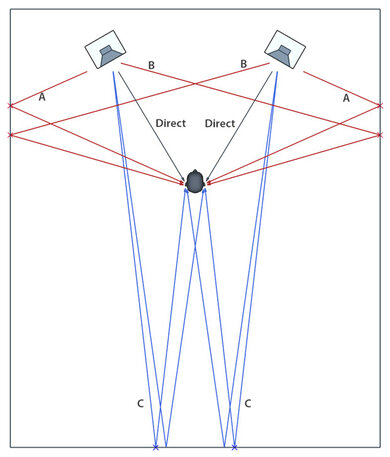

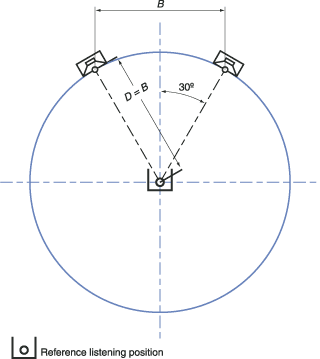
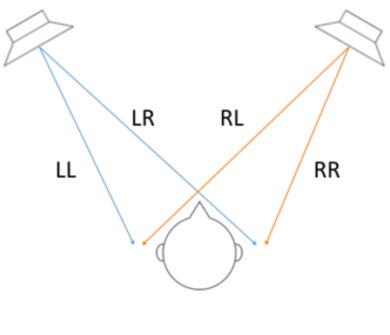
Our Tests
PRTF
To measure the amount of interaction between the pinna and headphones, we devised a PRTF test, short for pinna-related transfer function. For this test, we got an extra ear for our HMS II.3 dummy head, chopped its pinna off, and measured the frequency response of each headphone twice: once with the intact ear, and once with the ear with the missing pinna. The difference between the two frequency responses is the pair of headphones' PRTF.
Headphones' PRTF = (Frequency Response w/ Pinna) - (Frequency Response w/o pinna)
To come up with a benchmark to score our PRTF measurements against, we used a loudspeaker. It was positioned one meter in front of the HMS (our dummy head), and frequency response measurements were performed with and without the pinna every 30 degrees. We picked the loudspeaker PRTF at 30 degrees as the reference because that's where loudspeakers are positioned in a stereo setup, but as the graph below shows, there's a clear pattern emerging as the head is rotated.
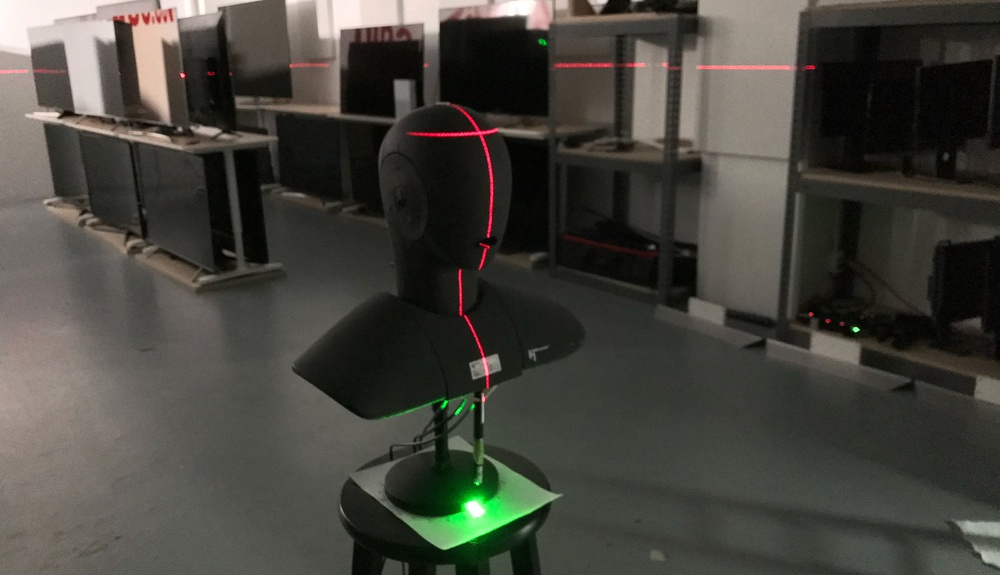
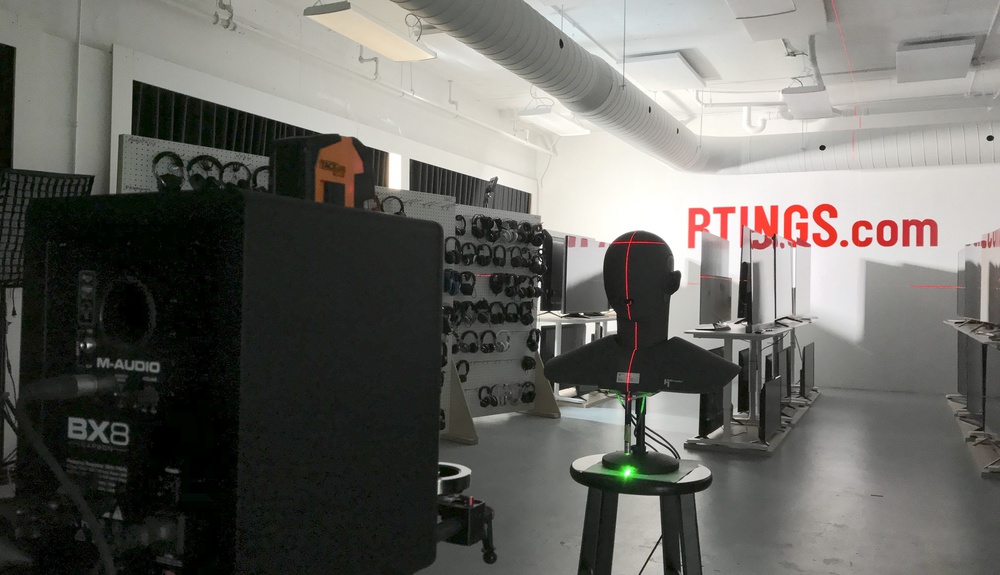
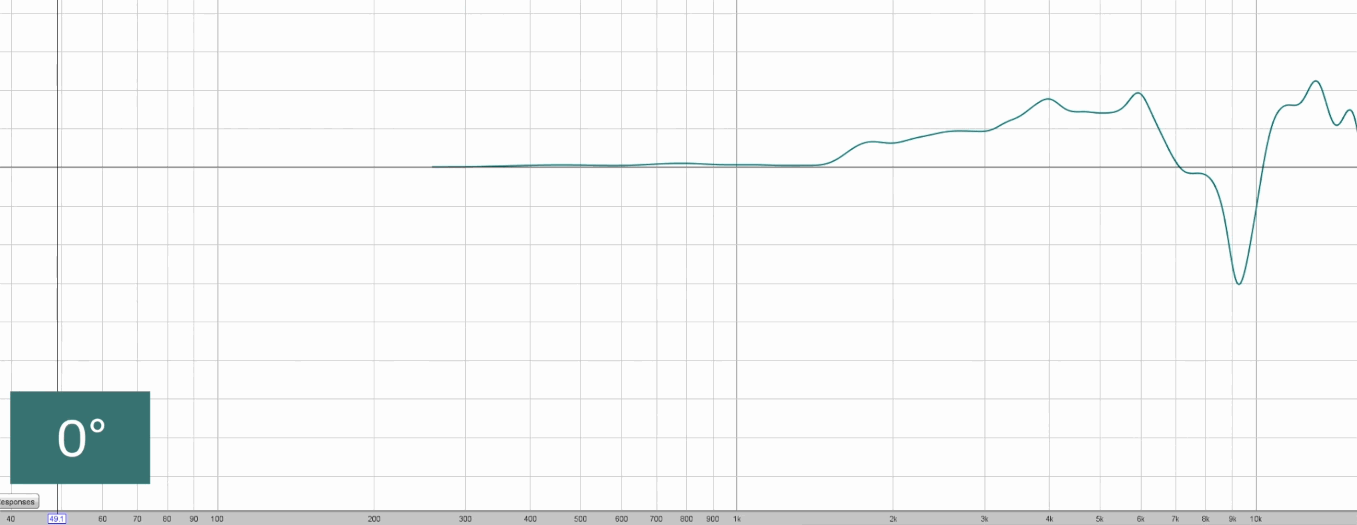
In the soundstage category in our reviews, PRTF calculations are divided into three: Accuracy, Size, and Distance.
PRTF Accuracy (Std. Dev.)
The accuracy value is derived by performing a standard deviation calculation of the PRTF response compared to the speaker reference PRTF between 2kHz and 7kHz. In other words, it shows how accurate the response shape is in that region compared to the reference PRTF response and is, therefore, mostly responsible for how natural the pinna-related effects on the soundstage will be.
As a rule of thumb, headphones with angled drivers and large and deep enclosures have the closest resemblance to our benchmark. That's why over-ear headphones tend to do better than on-ear headphones in this test. Also, some headphones show unusual peaks and dips in their PRTF responses. One possible cause is that these headphones have small ear cups, and they pinch or deform the pinna in a way that creates an unusual response, which may be perceived as odd and unnatural sounding.


PRTF Size (Avg.)
The size value is derived by performing an average amplitude calculation on the PRTF response between 2kHz and 7kHz, the frequency band which our pinnas naturally amplify (sometimes referred to as the 'Pinna Gain Region'). In other words, it shows the amount of interaction between the headphone and the pinna, regardless of its accuracy, and therefore, it plays a role in how large the soundstage will be perceived.
Headphones with angled drivers and large and deep enclosures tend to interact the most with the pinna. That's why over-ear headphones tend to do better than on-ears, earbuds, and in-ears in this test. Also, some headphones show an unusually high amount of pinna interaction in their PRTF responses. One possibility is that these headphones use the pinna to dampen the resonances of the enclosure, and when the pinna is removed for the PRTF test, those resonances can ring freely. In this case, the extra activation can be considered noise in our measurements.
PRTF Distance
We derive distance value by calculating the difference between the "average PRTF amplitude of the 2kHz-7kHz range" (i.e., PRTF Size) and the "lowest PRTF amplitude value in the 8kHz-12kHz range". In other words, PRTF distance looks for the depth of the 10kHz notch, which is mostly responsible for cues regarding the angle and elevation of the sound source.
As a general trend, headphones with angled drivers and large and deep enclosures tend to have PRTF responses that align more with our benchmark. That's why over-ear headphones tend to do better than on-ears, earbuds, and in-ears in this test.


With some headphones, the center frequency of the "10kHz notch" is slightly shifted upwards or downwards. Based on our tests, an upshift in the center frequency of the notch could actually represent cues for the elevation of the sound source.

Additional Information
Currently, we only perform PRTF measurements on over-ear and on-ear headphones. As a result, you won't see PRTF graphs in our reviews of earbuds, IEMs, or even open earbuds. That's because these types of headphones bypass the pinna and don't interact with it, and their PRTF response would basically be a flat line, as can be seen in the example below:
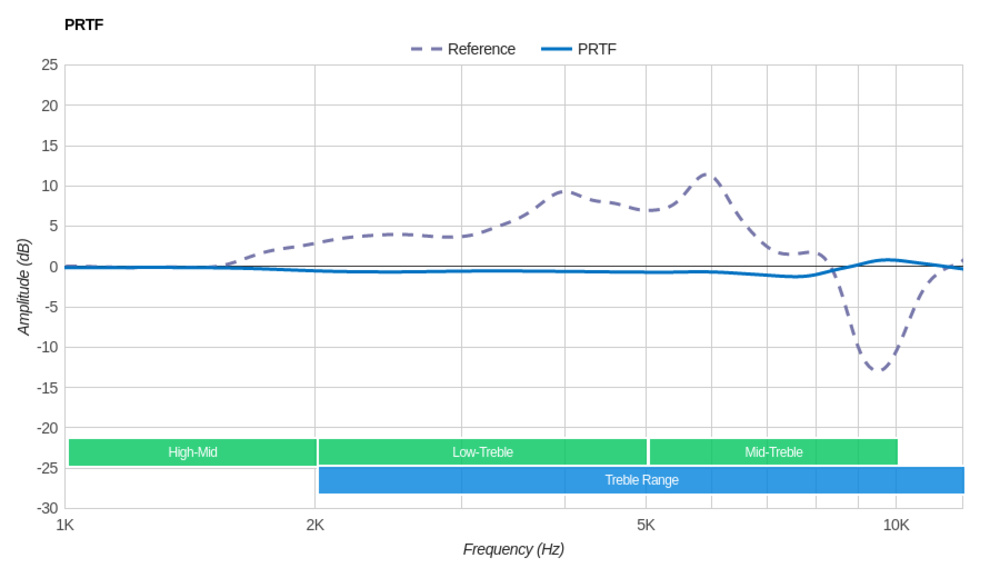
Ultimately, PRTF only provides partial insight into a pair of headphones' soundstage performance. Soundstage, as an audio phenomenon, is notoriously nebulous and difficult to measure. Each person's ears and brains are different, and while one pair of headphones' soundstage might sound open and immersive to one listener, others might disagree. That said, there's a good degree of alignment between headphones that perform well in our PRTF tests and those that the community agrees have a spacious soundstage, which is why we continue to include this test in our measurement suite.
What Isn't Included
- Room effects
- Head tracking
- Distance of the sound source
- DSP: soundstage effects created using digital signal processing
If you feel there's an item missing that should be included, please let us know in the comments or via email at feedback@rtings.com.
Recent Updates:
- 06/10/2025: We've updated this article to reflect changes made as part of our Headphones 2.0 Methodology.